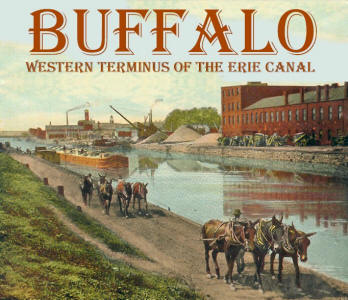|
From Buffalo’s Southtowns, three
streams; Cayuga, Buffalo and Cazenovia Creeks, flow generally
northward to conjoin into Big Buffalo Creek, now called the Buffalo
River. Just past their juncture, the river meanders and turns more
westerly toward the Lake Erie shoreline, and discharges into the
lake at Buffalo. In colonial times, another small rivulet existed,
called Little Buffalo Creek. It entered the Buffalo River just
before its confluence with the Lake.
When Buffalo was still the unincorporated
village of New Amsterdam, in the early 1800’s, Little Buffalo Creek
was the boundary between it and a settlement of aboriginal Senecas.
The historic Erie Canal was completed in 1825, after Buffalo had
prevailed over the village of Black Rock to become the Western
Terminus of the famed waterway. The excavated and lined portion of
the Canal initially ended at Little Buffalo Creek. There, Canal
packets from Albany and New York City could turn into the Creek, then into the Buffalo
River. They unloaded their goods or passengers, to be
transferred to craft plying Lake Erie.
On the completion
of the Canal, Governor De Witt Clinton, who conceived it, came to
Buffalo and boarded the packet boat Seneca Chief, which
held two cedar kegs filled with fresh water from Lake Erie, to be
transported to New York City via the new Canal and poured into the Atlantic Ocean. On the
Seneca Chief’s return trip, it carried a keg of Atlantic Ocean
water, which was poured into the Lake’s waters by Judge Samuel
Wilkeson, who stated “the waters of the
Lake were mingled with those of the Ocean; and we, in return, now
unite those of the Ocean with the Lake”.
[Buffalo Journal,
Nov. 29, 1825] Wilkeson eventually became
Mayor of Buffalo, and the Canal went on to change the history of the
nation. |
 |
|
The opening of the Erie Canal was greeted with much fanfare all
along its route, and with no less joy in New York City than in
Buffalo. On 'opening day', cannons were set up all along the
route of the canal, to signal from Buffalo to New York City and
back, that America's great West had been opened to waterborne
commerce.
Cadwallader D. Colden was a former Mayor of
New York City, and a United States Congressman from New York
State. A proponent of a national canal system, he was
commissioned by the Common Council of New York City to write
his Memoir on the Erie Canal during the last days of
its construction in 1825. Some excerpts from Colden's Memoir and its
Appendix appear on the following pages.
|
|

